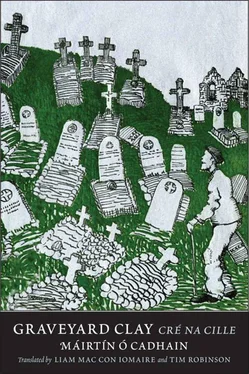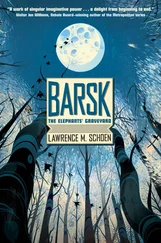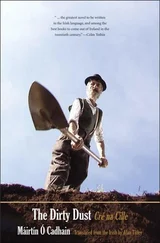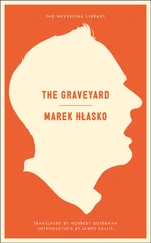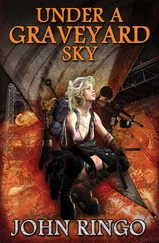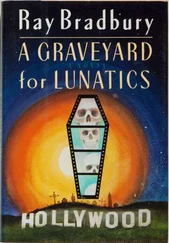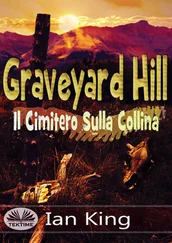In 2009, following the acquisition of Sáirséal Ó Marcaigh by Cló Iar-Chonnacht, the 1965 reprint was used as the basis for a soft-cover print run. The first edition contains a colophon in Irish on the end page:
Arna chur i gcló do Sháirséal agus Dill Teo. ag Foilseacháin Náisiúnta Teo., Cathair na Mart, idir Lá Fhéile Muire sa bhFómhar agus Lá Nollag, 1949.
(Printed for Sáirséal agus Dill Teo. by Foilseacháin Náisiúnta Teo., Westport, between 15th August and 25th December 1949.)
This text also appears in the second, third, and fourth reprints, with the additional information that the book was being printed by Dill agus Sáirséal Teoranta in Dublin, with a minor amendment to the wording of the formula in the third and fourth reprints. In a nod to publishing history, the 2009 reprint, under the imprint of Cló Iar-Chonnachta ( sic ) and designated generically as An Cló Seo (This Print), contains a colophon on the end page, which replicates the formula:
Arna chur i gcló do Chló Iar-Chonnachta Teo., ag Clódóirí Lurgan, Indreabhán, idir Lá Fhéile Muire sa bhFómhar agus Lá Nollag, 2009.
(Printed for Cló Iar-Chonnachta Teo. by Clódóirí Lurgan, Indreabhán, between 15th August and 25th December 2009.)
Translations of Cré na Cille
Cré na Cille was translated in full by Joan Trodden Keefe (1931–2013), and the translation formed the basis for a doctoral degree granted by the University of California, Berkeley, in 1984. As part of the dissertation, Trodden Keefe provided an introduction and notes to the translation. The graduate research was supervised by Professor Daniel Melia, and the dissertation was examined by Brendan P. O Hehir and Robert Tracey. This translation has been available for consultation in university libraries on microfiche but has not been in general circulation. Trodden Keefe proceeded to publish an extended literary analysis of Cré na Cille in the journal World Literature Today in 1985. 16
Another translation of the text was undertaken by Eibhlín Ní Allúráin (1922–2010) and Maitiú Ó Néill (1921–1992), 17who were closely associated with Máirtín Ó Cadhain. The translation was substantially completed but has not been published. An extract of this translation was published in the literary journal Krino 11, 18and also appeared in the Field Day Anthology of Irish Writing . 19Sections of the text have been translated by literary scholars for the purposes of explication or pedagogy, as in the case of Alfred Bammesberger, who included extracts from twentieth-century writers, including an extract from Cré na Cille , in a language teaching manual published in Heidelberg, Germany, in 1984. 20Philip O’Leary, Robert Welch, Declan Kiberd, and Brian Ó Broin have all provided their own versions of extracts in the course of scholarly commentary in English on aspects of the narrative. 21By their very nature, these extracts are relatively brief and serve primarily to cater for a non-Irish-speaking readership.
The Dirty Dust is Alan Titley’s version of Cré na Cille , published by Yale University Press in 2015 in the Margellos World Republic of Letters series, which treats especially of previously overlooked works of cultural and artistic significance. Initial enthusiasm regarding access to the narrative may ultimately be tempered by a more guarded analysis of the translation’s “free-wheeling” nature in general and a markedly creative interpretation of the text’s “rich and savage demotic base” in particular. 22
Translation of Ó Cadhain’s other works has been sporadic, but versions of Cré na Cille have been made available in Norwegian 23and Danish, 24offering interesting challenges for the translators in choosing suitably responsive target registers for their readership. A relatively limited number of Ó Cadhain’s short stories have been translated. Eoghan Ó Tuairisc (1919–1982) made a study of stories from the earlier corpus, the collection An Braon Broghach in particular. 25Some twenty-five years later, in 2006, a further two stories were translated by Louis de Paor, Mike McCormack, and Lochlainn Ó Tuairisg and published by the Cúirt International Festival of Literature. 26Ó Cadhain’s novella An Eochair , a study of a minor civil servant and his literal and metaphoric entrapment, from the narrative collection An tSraith ar Lár , was translated by Louis de Paor and Lochlainn Ó Tuairisg and published by Dalkey Archive Press in 2015. 27
Michael Cronin made an impassioned plea for “ Cré na Cille in English” in the Irish Times in 2001: “Translation excites desire, it does not cancel it. The better the translation, the more compelling the case for going to the original.” 28The relative paucity of translations can be ascribed to a reluctance to embroil oneself in copyright difficulties, and to the notion held by many critics that Ó Cadhain’s Irish and use of language is “difficult.” There is also a sense of linguistic piety or cultural decorum that has served to warn off potential translators. A translator may very well take the view that one tampers with canonical texts at one’s peril; however, Tim and I took Michael Cronin’s plea to heart and committed ourselves to producing this English-language translation of Cré na Cille .
The Language
When it was established that folk or popular idiom, “caint na ndaoine,” would be the medium of modern literary Irish, emerging authors and critics became keenly aware of the importance of mastery of the registers of Irish as spoken in the Gaeltacht, the regions where primarily Irish is used. The extent of dialectal variation in Irish, the slow development of Irish language literacy in post-independent Ireland, the absence of a standardised orthography, and the inadequacy of available dictionaries meant that for many readers texts from authors such as Máirtín Ó Cadhain and Séamas Ó Grianna were cherished as lexical treasure troves, to be revered as regionalised glossaries as much as literary masterpieces. The Irish-English Dictionary of the Reverend Patrick S. Dinneen (1927) was regarded as a superb work of scholarship, and, while it is probably more representative of Munster Irish than other dialects, Ó Cadhain praised it profusely, advising all writers of Irish that there is no better bedfellow than Dinneen’s dictionary. 29
The appearance of Cré na Cille , whose narrative consists entirely of dialogue, was bound to present challenges for ordinary readers and literary critics with only a scant familiarity with Connacht, much less Conamara, Irish. It is also worth noting that the seminal monograph series on Irish phonetics and accidence published by the Dublin Institute of Advanced Studies began appearing during the 1940s. All these factors served to emphasise a lexical, as opposed to a literary, analysis of the text in the first instance.
Reception and Interpretation
In the early reviews by Tomás Ó Floinn, Daniel Corkery, and David Greene in 1950 we are told that the author has excelled in the crafting of his medium, that this medium is heavily indebted to the speech of his native Conamara Gaeltacht, and that, while this is a criterion of excellence in itself, the text is difficult. 30This has been challenged by Róisín Ní Ghairbhí, who states that syntactical structures are relatively straightforward, and while individual words or phrases may be rare or unusual, their significance and meaning are not beyond the resources of a reasonably alert reader. 31Other critics have pointed out that Cré na Cille “is not simply a tour de force of conversational Irish,” 32and that “Ó Cadhain has been criticised unjustly by critics who didn’t understand what he was saying.” 33An Aran Islander and native Irish speaker himself, Breandán Ó hEithir went on to say: “ Cré na Cille is a great comic work and by far and away the funniest in modern Irish, as Ciarán Ó Nualláin [brother of Myles na gCopaleen] pointed out when it was published. Apart from Evelyn Waugh and Jaroslav Hašek no author makes me laugh as heartily and as regularly as Máirtín Ó Cadhain in Cré na Cille .” 34
Читать дальше
